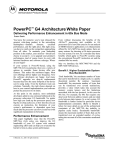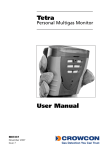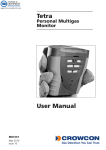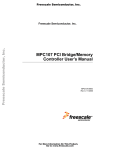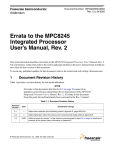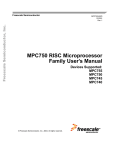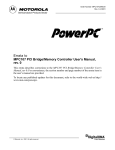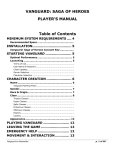Download MPC107 Revision 1.3 and 1.4: Comparison and Compatibility
Transcript
Freescale Semiconductor, Inc. Freescale Semiconductor, Inc... MPC107 Revision 1.3 and 1.4: Comparison and Compatibility Doug McQuaid CPD Applications risc10@email. sps.mot.com This document describes electrical and functional differences between Rev 1.3 and Rev 1.4 of the MPC107 PCI Bridge/Memory Controller, which provides a bridge between the Peripheral Component Interconnect (PCI) bus and the MPC603e, MPC740, MPC750, MPC745, MPC755, MPC7400 and MPC7410 PowerPC™ host processors. This document covers the following topics: Topic Section 1, “Overview” Section 2, “Electrical Differences” Section 3, “Functional Differences” Section 4, “Compatibility Factors” Section 5, “Conclusion” Section 6, “Document Revision History” 1 Page 1 2 3 5 7 7 Overview For a few years now, the production revision of the MPC107 has been Rev 1.3. However, this version of the device is limited to a processor/memory bus frequency of 100 MHz and has errata that some customers have deemed unsuitable for their design requirements. Recently a new revision of the MPC107, Rev 1.4, was introduced to implement fixes for the errata to make it more suitable for new designs. Specification changes that manufacturing supports also addressed the frequency limitation. Because many existing designs are unaffected by the 100-MHz limit and the errata on Rev 1.3, and because Rev 1.4 introduces timing and functional changes to the 107, many customers choose to continue specifying Rev 1.3 in their designs. This document, which describes the differences between Rev 1.3 and Rev 1.4, provides help to assess which revision is appropriate for a specific design and what changes might be necessary when migrating a system design from Rev 1.3 to Rev 1.4. © Freescale Semiconductor, Inc., 2004. All rights reserved. For More Information On This Product, Go to: www.freescale.com Freescale Semiconductor, Inc. Electrical Differences Table 1 describes how to distinguish between Rev 1.3 and Rev 1.4 devices. The orderable part number and the part marking contain a revision code that refers to the die mask revision number. Reading the Revision ID register at configuration address offset 0x08 can determine the revision level of an installed device. Table 1. Identifying Revision Level MPC107 Die Mask Revision Level Revision Code Revision ID Register (offset 0x08) 1.3 C 0x13 1.4 D 0x14 Freescale Semiconductor, Inc... Some of the MPC107 documentation is not updated to reflect the differences between Rev 1.3 and Rev 1.4 of the device. The following documents were written before the changes in Rev 1.4 of the MPC107 were known: • • MPC107 PCI Bridge/Memory Controller User’s Manual (MPC107UM/AD), Rev 0. 11/2000 Application notes — Designing a Local Bus Slave Interface (AN1846/D), Rev 0, 3/2000 — MPC107 Design Guide (AN1849/D), Rev 0.8, 8/2000 These documents will be updated, but until their revision date surpasses the initial date of this application note, they will not contain the information presented herein regarding Rev 1.4. The following documents have been updated to reflect the Rev 1.4 changes: • • • 2 MPC107 PCI Bridge/Memory Controller Hardware Specifications (MPC107EC/D), Rev 2, 12/2002 MPC107 Part Number Specification for the XPC107APXnnnWx Series (MPC107APXPNS/D), Rev 1, 11/2002 MPC107 PCI Bridge/Memory Controller Chip Errata (MPC107CE/D), Rev 5, 7/2002 Electrical Differences The only changes in the electrical specifications are to allow the MPC107 to achieve 133-MHz processor/memory bus operation timing. Note that these are specification changes that manufacturing supports, and are not design changes. Therefore, Rev 1.4 devices marked for 100-MHz operation have the same electrical characteristics as Rev 1.3 devices. The MPC107 Part Number Specification for the XPC107APXnnnWx Series document describes the electrical differences for the 133-MHz-rated device in detail. Table 2 summarizes the changes for the 133-MHz-rated Rev 1.4 MPC107. Table 2. Electrical Differences—100 MHz/133 MHz Rev 1.3/Rev 1.4 (100-MHz Device) Rev 1.4 (133-MHz Device Only) Maximum 60x and memory bus frequency 100 MHz 133 MHz Supply voltages—core, PLL, and DLL (VDD, AVDD, and LAVDD) 2.5 VDC 2.7 VDC Electrical Characteristic MPC107 Revision 1.3 and 1.4: Comparison and Compatibility For More Information On This Product, Go to: www.freescale.com Freescale Semiconductor, Inc. Functional Differences Table 2. Electrical Differences—100 MHz/133 MHz (continued) Rev 1.3/Rev 1.4 (100-MHz Device) Rev 1.4 (133-MHz Device Only) 5.5 nsec 4.5 nsec 105 ˚C 85 ˚C Power consumption See MPC107 hardware specifications Slightly higher due to elevated supply voltage I2C frequencies See MPC107 hardware specifications Higher due to higher memory bus frequency of 133 MHz (the divisors are the same) Frequency range limited to 100 MHz for PLL[0:4] configurations 0x5, 0x8, and 0xC Frequency range higher for PLL[0:4] configurations 0x5, 0x8, and 0xC Electrical Characteristic 60x and memory interface signals —output valid time (Specs 12 b and 12e) Freescale Semiconductor, Inc... Maximum die junction temperature (Tj) PLL[0:4] configurations 3 Functional Differences Rev 1.3 of the MPC107 has known errata that affect functionality. Rev 1.4 fixes some of those errata, but implementing the fixes introduced functionality changes. The following sections describe the specific Rev 1.3 errata that Rev 1.4 addressed. 3.1 Fast Back-to-Back Capability For all revisions of the MPC107 before Rev 1.4, bit 7 of the PCI status register is hardwired to 1, indicating the MPC107 can support fast back-to-back transactions. Due to a chip errata (#17), if an external PCI master issues a type 2 fast back-to-back transaction (read or write) to a MPC107, the transaction causes data corruption. (Type 2 fast back-to-back transactions access multiple targets sequentially.) The suggested work-around for this errata is to use software to disable the ability to run fast back-to-back transactions on any potential master devices by clearing bit 9 of the PCI command register in the master device. The solution implemented in Revision 1.4 of the MPC107 is to hardwire bit 7 of the PCI status register to 0, indicating that it is not capable of accepting fast back-to back transactions as a target. 3.2 MPC7450 Compatibility Revisions of the MPC107 before Rev 1.4 have compatibility issues with the MPC7450 and its derivatives. The compatibility issues are documented as Errata # 18 in the MPC107 chip errata. The MPC7450 implementation of the 60x bus protocol is slightly more restrictive in that data must never be transferred before the last cycle of the ARTRY window (the cycle after AACK is asserted). Similarly, TEA must not be asserted to terminate a data tenure before the last cycle of the ARTRY window. The actual protocol restriction for the MPC7450 is that any transaction receiving a simultaneous AACK and TA/TEA must not be retried. Improperly forwarded data causes data corruption in the code stream. In addition, any transaction that requires a data tenure that follows a transaction receiving a simultaneous MPC107 Revision 1.3 and 1.4: Comparison and Compatibility For More Information On This Product, Go to: www.freescale.com Freescale Semiconductor, Inc. Functional Differences AACK and TA/TEA must not be retried. When the MPC7450 receives a simultaneous AACK and TA/TEA, it sets an internal sticky flag that causes the next transaction to ignore ARTRY. For revisions of the MPC107 before Rev 1.4, data is returned to the processor starting with the cycle when AACK is asserted, which is one cycle before that permitted by the MPC7450. Before Rev 1.4, the MPC107 may drive DBGn (and DBGLB) as early as the cycle in which TS is asserted. The problem is aggravated in dual-processor systems and systems where PCI accesses to memory cause significant snoop or retry activity on the 60x bus where 60x bus traffic is high. Beginning with Rev 1.4, the MPC107 no longer issues the first TA (or TEA) for a data tenure simultaneously with the associated AACK for any transactions. To guarantee that TA is not asserted on or before AACK, the timings for DBGn and DBGLB were also changed. Freescale Semiconductor, Inc... 3.2.1 Local Bus Slave Parameters To implement the fix for MPC7450 compatibility, two local bus slave parameters, PICR1[CF_LBA_EN] and PICR2[CF_LBCLAIM_WS], were eliminated beginning with Rev 1.4. The CF_LBA_EN parameter enables or disables the local bus slave functionality on revisions before Rev 1.4 whereas, starting with Rev 1.4, local bus slave functionality is always enabled. The CF_LBCLAIM_WS parameter controls when the 107 samples the LBCLAIM input signal from the local bus slave on revisions before 1.4. Starting with Rev 1.4 of the 107, the PICR2[CF_APHASE_WS] parameter controls the timing of both the address phase and the sampling of LBCLAIM. 3.3 Latency for PCI Accesses to Local Memory Due to a chip errata (#19) on revisions of the MPC107 before Rev 1.4, the processor can prevent a PCI agent or DMA transfer from accessing the SDRAM and thereby affect the minimum PCI and/or DMA access latency if the processor is performing a series of pipelined reads or writes. PCI and DMA accesses to local memory may stall if snooping is disabled (PICR2[NO_SNOOP_EN] = 1) because pipelined processor transactions have a priority 1.5 (see Table 12-2 of the MPC107 Bridge/Memory Controller User’s Manual). The suggested work-around is to enable snooping (PICR2[NO_SNOOP_EN] = 1), even though the hardware-managed coherency is not needed. As an additional step, in single-processor systems, the GBL signal to the processor may be pulled down to eliminate false ARTRYs due to pipeline collisions. Adding fairness to the internal arbitration logic that does not allow the pipelined 60x transaction to keep winning over non-snooped PCI/DMA initiated read transactions in Rev 1.4 of the MPC107 fixed the errata. 3.4 60x Bus Grants After sync or eieio Broadcasts Due to a chip errata (#20) on MPC107 devices before Rev 1.4, if the processor issues a sync or eieio instruction to the MPC107, the MPC107 does not grant the 60x bus to any processor until all the internal write buffers are empty. These buffers are the processor-to-PCI-write data buffers (PRPWB0 and PRPWB1), the PCI-to-local-memory-write buffers (PCMWB0, and PCMWB1), and the copyback buffer. In this case, a PCI device can perform continuous accesses into SDRAM so that the internal buffers (PCMWB0, PCMWB1, and copyback) are never empty. In such a case, the processor is prevented from progressing beyond the sync/eieio address broadcast. The suggested work-around is to disable broadcasts of address-only transactions (HID0[ABE]=0) on processors that implement the ABE bit. For systems using processors that do not implement the ABE bit (such as the MPC7410), the work-around is much more difficult, involving external logic that decodes MPC107 Revision 1.3 and 1.4: Comparison and Compatibility For More Information On This Product, Go to: www.freescale.com Freescale Semiconductor, Inc. Compatibility Factors address-only broadcasts and inhibits the PCI arbitration signals to allow for transactions in the internal PCMWBs buffers to complete to memory before resuming normal operation. The solution implemented in Revision 1.4 of the MPC107 is to remove the dependency on flushing the PCI-to-local-memory-write buffers (PCMWBs) after a sync/eieio broadcast before the 107 can grant the bus to the processor. Thus, only the processor-to-PCI-write buffers (PRPWBs) are flushed before the bus is granted to the processor. 4 Compatibility Factors Freescale Semiconductor, Inc... This section describes compatibility issues that may arise when migrating a MPC107-based design from Rev 1.3 to Rev 1.4. 4.1 DBGn and DBGLB Timing As described in Section 3.2, “MPC7450 Compatibility,” to guarantee that TA is not asserted on or before AACK, the timings for DBGn and DBGLB were changed in Rev 1.4 to fix the MPC7450-compatibility problem. Before Rev 1.4, the MPC107 may drive DBGn (and DBGLB) as early as the cycle in which TS is asserted. Figure 1 shows the signal timing for DBGn and DBGLB on Rev 1.3 and Rev 1.4 devices. 60x Bus Clock TS AACK 60x Address DBGn Rev 1.3 TA Data DBGn Rev 1.4 TA Data Single Beat Burst Figure 1. Rev 1.3 and Rev 1.4 DBGn Signal Timing NOTE For Rev 1.4 of the MPC107, DBGn is asserted coincident with AACK. If a Rev 1.3 system design incorporates external logic that depends on the timing of DBGn or DBGLB, the external logic must be modified to accommodate the altered timing of Rev 1.4. MPC107 Revision 1.3 and 1.4: Comparison and Compatibility For More Information On This Product, Go to: www.freescale.com Freescale Semiconductor, Inc. Compatibility Factors 4.2 Local Bus Slave Compatibility As described in Section 3.2.1, “Local Bus Slave Parameters,” an impact occurs on local bus slave functionality when moving from Rev 1.3 to Rev 1.4. Two local bus slave parameters, PICR1[CF_LBA_EN] and PICR2[CF_LBCLAIM_WS] were eliminated Freescale Semiconductor, Inc... Even though the CF_LBA_EN parameter was eliminated in Rev 1.4, initialization software that sets this bit to enable the local bus slave functionality do not cause any errors. Software that clears CF_LBA_EN to disable the local bus slave functionality does not cause any errors; however, the functionality is always enabled in Rev 1.4 and the clearing of this bit is ignored. A Rev 1.3 design has no reason to rely on disabling the local bus slave functionality, and thus software should not be impacted. The elimination of the CF_LBCLAIM_WS parameter in Rev 1.4 may affect initialization software. Starting with Rev 1.4 of the MPC107, the PICR2[CF_APHASE_WS] parameter controls the timing of both the address phase and the sampling of LBCLAIM. Software that attempts to program CF_LBCLAIM_WS does not cause any errors on Rev 1.4, but the LBCLAIM sampling logic ignores the parameter. Consider this situation to assert LBCLAIM in the appropriate cycle. Many customers use equal settings for CF_APHASE_WS and CF_LBCLAIM_WS, and the change does not affect them. However, if the initialization code is setting CF_APHASE_WS greater than CF_LBCLAIM_WS and a local bus slave asserts LBCLAIM before CF_APHASE_WS expires, a Rev 1.4 MPC107 does not recognize the assertion of LBCLAIM and asserts the appropriate number of TAs for the transaction. Typically in this situation, the system eventually hangs. The work-around is to adjust CF_APHASE_WS for a shorter duration to accommodate the assertion of LBCLAIM or to modify the local bus slave to delay the assertion of LBCLAIM until CF_APHASE_WS expires. 4.3 Migrating from 100 MHz to 133 MHz If the purpose of migrating to Rev 1.4 is to increase the processor/memory bus frequency from 100 MHz to 133 MHz, the system design must account for the electrical differences that Table 2 describes. Note that not all Rev 1.4 devices are rated for 133-MHz operation. In 133-MHz systems, use only those devices that are specifically rated for 133-MHz operation. Most, but not necessarily all, system designs should be re-laid out to operate properly at 133 MHz. Because the 133-MHz Rev 1.4 MPC107 requires 2.7 VDC supply voltages for the core, PLL, and DLL, the power supply of an existing Rev 1.3 design should be augmented to support the additional increased supply voltage. Follow the recommendations in the MPC107 Hardware Specifications and in the MPC107 design guide application note (AN1849/D) concerning memory timing. In general, for best signal integrity, keep trace lengths for SDRAM signals as short as possible and keep capacitive loads to a minimum (or use registered DIMMs that buffer the memory control signals). MPC107 Revision 1.3 and 1.4: Comparison and Compatibility For More Information On This Product, Go to: www.freescale.com Freescale Semiconductor, Inc. Conclusion 5 Conclusion Table 3 provides a summary of which revision of the MPC107 is appropriate for specific design requirements. For designs that do not depend on the listed requirements, either revision provides the functionality described in the MPC107 user’s manual. Table 3. Which Revision To Use? Design Requirement MPC107 Rev 1.3 MPC107 Rev 1.4 Not suitable Suitable (with 133 MHz-rated part) May not be suitable (Errata #17) Suitable, but fast back-to-back transactions to the 107 are still not supported. See Section 3.1, “Fast Back-to-Back Capability,” for more information. Not-suitable (Errata #18) Suitable Local bus slave device Suitable Existing logic/initialization software may need modification. See Section 4.2, “Local Bus Slave Compatibility,” for more information. External logic that relies on DBGn or DBGLB timing Suitable Existing logic may need modification. See Section 4.1, “DBGn and DBGLB Timing,” for more information. Snooping of PCI-to-local memory transactions disabled (PICR2[NO_SNOOP_EN] = 1) May not be suitable (Errata #19) Suitable MPC7400/MPC7410 processor May not be suitable (Errata #20) Suitable 133-MHz processor/memory bus Freescale Semiconductor, Inc... External PCI masters that may run Type 2 fast-back-to-back transactions MPC7450 family processor 6 Document Revision History Table 4 details revisions and changes to this application note. Table 4. Document Revisions Rev. No. Substantive Changes 0.0 Initial release 0.1 Nontechnical reformatting MPC107 Revision 1.3 and 1.4: Comparison and Compatibility For More Information On This Product, Go to: www.freescale.com Freescale Semiconductor, Inc. How to Reach Us: Home Page: www.freescale.com Freescale Semiconductor, Inc... E-mail: [email protected] USA/Europe or Locations Not Listed: Freescale Semiconductor Technical Information Center, CH370 1300 N. Alma School Road Chandler, Arizona 85224 +1-800-521-6274 or +1-480-768-2130 [email protected] Europe, Middle East, and Africa: Freescale Halbleiter Deutschland GmbH Technical Information Center Schatzbogen 7 81829 Muenchen, Germany +44 1296 380 456 (English) +46 8 52200080 (English) +49 89 92103 559 (German) +33 1 69 35 48 48 (French) [email protected] Japan: Freescale Semiconductor Japan Ltd. Headquarters ARCO Tower 15F 1-8-1, Shimo-Meguro, Meguro-ku, Tokyo 153-0064 Japan 0120 191014 or +81 3 5437 9125 [email protected] Asia/Pacific: Freescale Semiconductor Hong Kong Ltd. Technical Information Center 2 Dai King Street Tai Po Industrial Estate Tai Po, N.T., Hong Kong +800 2666 8080 [email protected] For Literature Requests Only: Freescale Semiconductor Literature Distribution Center P.O. Box 5405 Denver, Colorado 80217 1-800-441-2447 or 303-675-2140 Fax: 303-675-2150 [email protected] Information in this document is provided solely to enable system and software implementers to use Freescale Semiconductor products. There are no express or implied copyright licenses granted hereunder to design or fabricate any integrated circuits or integrated circuits based on the information in this document. Freescale Semiconductor reserves the right to make changes without further notice to any products herein. Freescale Semiconductor makes no warranty, representation or guarantee regarding the suitability of its products for any particular purpose, nor does Freescale Semiconductor assume any liability arising out of the application or use of any product or circuit, and specifically disclaims any and all liability, including without limitation consequential or incidental damages. “Typical” parameters which may be provided in Freescale Semiconductor data sheets and/or specifications can and do vary in different applications and actual performance may vary over time. All operating parameters, including “Typicals” must be validated for each customer application by customer’s technical experts. Freescale Semiconductor does not convey any license under its patent rights nor the rights of others. Freescale Semiconductor products are not designed, intended, or authorized for use as components in systems intended for surgical implant into the body, or other applications intended to support or sustain life, or for any other application in which the failure of the Freescale Semiconductor product could create a situation where personal injury or death may occur. Should Buyer purchase or use Freescale Semiconductor products for any such unintended or unauthorized application, Buyer shall indemnify and hold Freescale Semiconductor and its officers, employees, subsidiaries, affiliates, and distributors harmless against all claims, costs, damages, and expenses, and reasonable attorney fees arising out of, directly or indirectly, any claim of personal injury or death associated with such unintended or unauthorized use, even if such claim alleges that Freescale Semiconductor was negligent regarding the design or manufacture of the part. AN2455 Rev 0.1 For More Information On This Product, Go to: www.freescale.com










